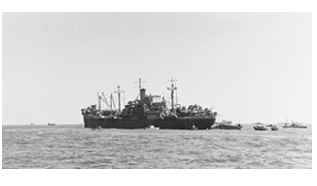On June 5, 1944 Symbolically led by a Polish Navy-commissioned destroyer, 255 minesweepers sailed into the English Channel. On their way to the Bay of Seine, they were followed by 1,213 warships, 4,126 landing craft, 736 ancillary craft, and 864 merchant vessels. Divided into 5 code-named sectors- - Utah, Omaha, Gold, Juno, and Sword -- the target was 50 miles of Nazi-held Normandy coast.
Sailing -- in gusty winds of 14-20 knots, with occasional 4-6 foot waves -- on a mine swept channel marked by lighted buoys, approximately 7,000 heavily laden floating vessels carried more than 150,000 soldiers representing America, the United Kingdom, Canada, Free France, Norway, Poland, Australia, Belgium, Czechoslovakia, Netherlands, New Zealand, and Greece.
 Under Rear Admiral Don Pardee Moon, the attack transport ship USS Bayfield was flagship for the Utah Beach landings. Bayfield carried Major General J. Lawton Collins, commander of the U.S. Army VII Corps, and Major General Raymond Barton, commander of the U.S. Army 4th Infantry Division. Also on Bayfield were President’s son, Brigadier General Theodore Roosevelt, Jr. and U.S. Navy Rocket Ship Gunner’s Mate “Yogi” Berra, who served on rocket boats that -- to protect soldiers landing on the beach -- fired into Nazi machine gun nests,
Under Rear Admiral Don Pardee Moon, the attack transport ship USS Bayfield was flagship for the Utah Beach landings. Bayfield carried Major General J. Lawton Collins, commander of the U.S. Army VII Corps, and Major General Raymond Barton, commander of the U.S. Army 4th Infantry Division. Also on Bayfield were President’s son, Brigadier General Theodore Roosevelt, Jr. and U.S. Navy Rocket Ship Gunner’s Mate “Yogi” Berra, who served on rocket boats that -- to protect soldiers landing on the beach -- fired into Nazi machine gun nests,
Supreme Commander of the Allied Expeditionary Force was former football coach General Dwight D. Eisenhower. Initially developed by Lieutenant-General Frederick Morgan, complex invasion plans assembled 7000 vessels of differing speeds and sizes in groups of ships of similar speeds that would advance at the speed of the slowest vessel.
The convoy of ships under the Bayfield's command arrived near Utah Beach at 2:29 A.M. June 6, 1944.


 Under Rear Admiral Don Pardee Moon, the attack transport ship USS Bayfield was flagship for the Utah Beach landings. Bayfield carried Major General J. Lawton Collins, commander of the U.S. Army VII Corps, and Major General Raymond Barton, commander of the U.S. Army 4th Infantry Division. Also on Bayfield were President’s son, Brigadier General Theodore Roosevelt, Jr. and U.S. Navy Rocket Ship Gunner’s Mate “Yogi” Berra, who served on rocket boats that -- to protect soldiers landing on the beach -- fired into Nazi machine gun nests,
Under Rear Admiral Don Pardee Moon, the attack transport ship USS Bayfield was flagship for the Utah Beach landings. Bayfield carried Major General J. Lawton Collins, commander of the U.S. Army VII Corps, and Major General Raymond Barton, commander of the U.S. Army 4th Infantry Division. Also on Bayfield were President’s son, Brigadier General Theodore Roosevelt, Jr. and U.S. Navy Rocket Ship Gunner’s Mate “Yogi” Berra, who served on rocket boats that -- to protect soldiers landing on the beach -- fired into Nazi machine gun nests,

